Seafloor
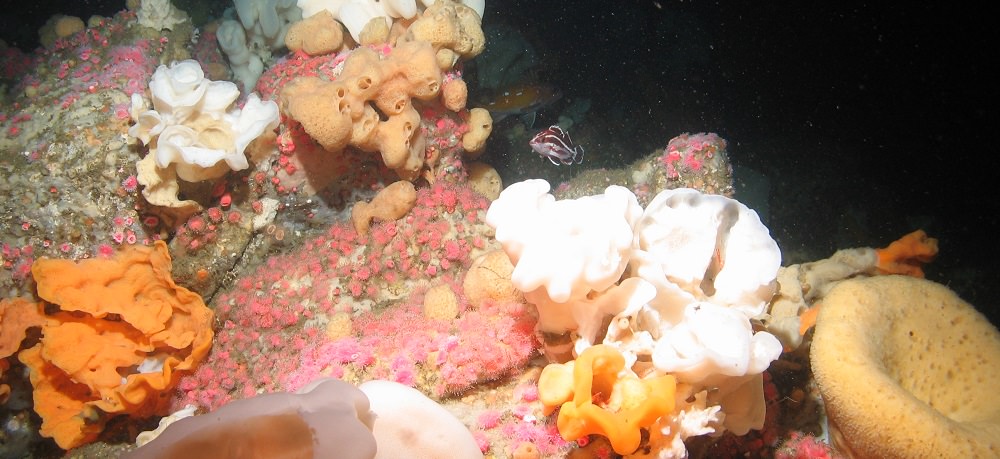
The northwest seafloor of Rittenburg Bank is covered with a diverse variety of sponges, corals and
rockfish.
Photo credit: NOAA
Seafloor Habitat Overview
The Greater Farallones sanctuary has many geologic features that result in a variety of seafloor habitat including underwater banks on the sea shelf, canyons, escarpment, and a variety of mixed habitat including sand, mud, bedrock, boulders, and smaller rocks, such as cobble and gravel.
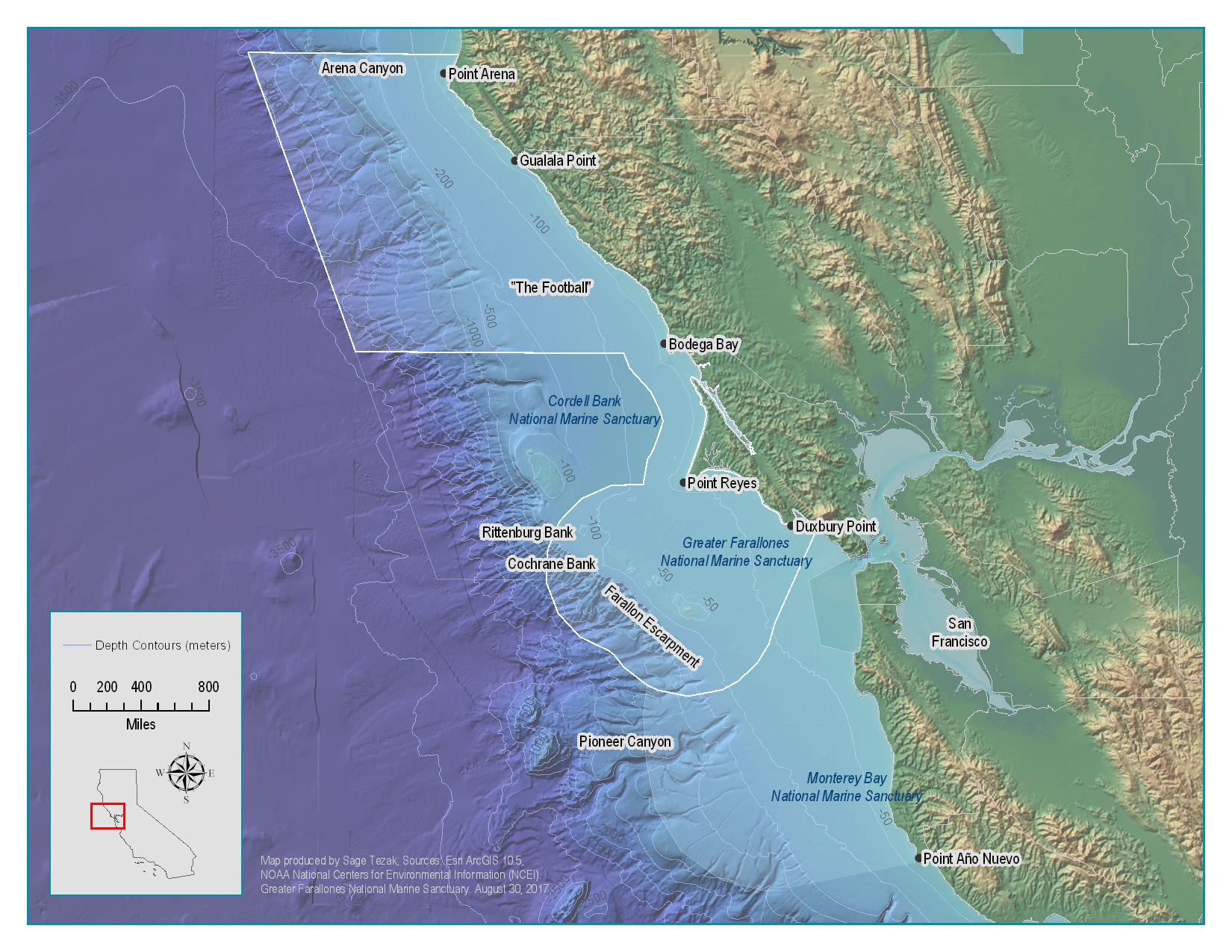
One of the most amazing habitats encountered and explored in the sanctuary is biogenic habitat, or structure-forming organisms such as coral, sponges, sea pens, sea whips and sea fans. Several of these habitats have recently been explored and characterized including: The Football, Rittenburg Bank, Cochrane Bank, Farallon Escarpment, Arena Canyon, and in the northern portion of Monterey Bay sanctuary, Pioneer Canyon.
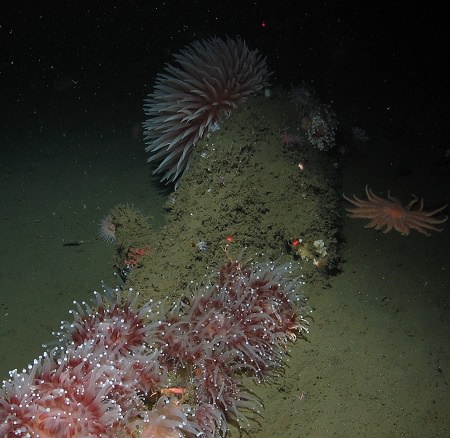
Importance of Corals
There are many functions deep sea corals (DSC) and sponges provide to the ocean ecosystem including the potential for biomedical uses. In general, deep sea corals and sponges provide shelter especially for larval and juvenile fish and invertebrates, areas for breeding and brooding, and food for many species of fishes and invertebrates. DSC grow extremely slowly, only a few mm to cm per year (Roark 2005). Once damaged, a coral colony may take decades if not centuries to regrow back to its original size and complexity. The health of the substrate on which corals grow is important for the health of coral and surrounding ecosystem. Damage to supporting rock pinnacles, particularly those pinnacles that are free from siltation, is permanent and reduces the value of substrate to support deep sea coral and sponge colonies.
Deep-sea gorgonian corals also provide habitat for many other creatures. The corals add habitat complexity, altering the sea floor by adding a large structure for other organisms to climb up and to reach higher into the water column. Many of these organisms are also suspension feeders, like the corals; the higher up they get into the water column, the more food they will find. We find many invertebrates -- including brittle stars, basket stars, crinoids (sea lilies), polychaetes, pinch bugs, and sponges -- living on coral trees. Thus, another goal of our surveys will be to document the associations between the corals and all these critters.
By studying bamboo and black corals we can better understand how El Niño cycles influence our ecosystem and predict how a changing climate will shape our marine wildlife and habitats. Understanding these influences can help managers determine how to alleviate other pressures, like extraction, pollution, smothering, bycatch, crashing, so that our fisheries remain sustainable, and help make the corals more resilient to climate change.
Deep Rocky Reefs and Banks
Deep rocky reefs and submerged banks typically extend up into the water column from the continental shelf,
providing increased circulation of nutrients for increased productivity of fish and invertebrates. Their
vertical
structure and mixed hard substrate support diverse biological assemblages. Deep rocky reefs and banks
provide
habitat for settlement of larvae from the water column. Our rocky reefs provide shelter and food for young
growing, rockfish, octopus, white plumed anemones, sea stars and tube polychaetes. Deep rocky reefs and
banks with
mixed substrates of hard and soft sediment are vulnerable to a variety of human activities, including:
trawling,
burying, crushing, scouring and entanglement from cables, and even contaminants.
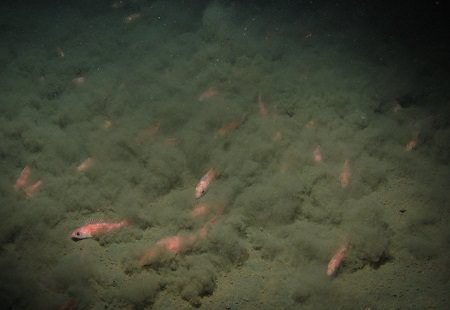
Canyons
Submarine canyons are very diverse, because they extend across shallow waters to the deep sea. This great diversity of depths means they are habitats with an incredible diversity of organisms. Submarine canyons have mobile fishes and invertebrates, which aggregate in canyon heads, along canyon walls, and crevices. The crests of pinnacles along the canyon walls are ideal habitats for deep sea corals and sponges because it has favorable bare rock, a steady food supply from increased water circulation, and reduced siltation. Research has shown that deep sea corals and sponges serve as breeding and brooding grounds for commercial harvested fish, such as sablefish (black cod), rockfish, lingcod, etc.
Submarine canyons are vulnerable to a variety of human activities, including: trawling, burying, crushing, scouring and entanglement from cables, and even contaminants. The risk of pollutant bioaccumulation is higher in submarine canyons than in surrounding waters because the flow of sediments and pollutants tends to be concentrated in canyons. These processes may also lead to an accumulation of marine debris. Reduction or elimination of these pressures will aid in increased biodiversity and health of deep sea coral communities within the sanctuaries.
Escarpment and Continental Slope
The continental slope is the break between the continental shelf and abyssal plain. In our region the slope is named Farallon Escarpment, which is steeply sloped and ranges in depth from 180 to over 2000 meters. Conditions quickly change along the depths of the slope, with a reduction of temperature and dissolved oxygen and intense pressures. The organisms that live along the escarpment move very slowly and often can be seen huddling in cervices and perched on corals.
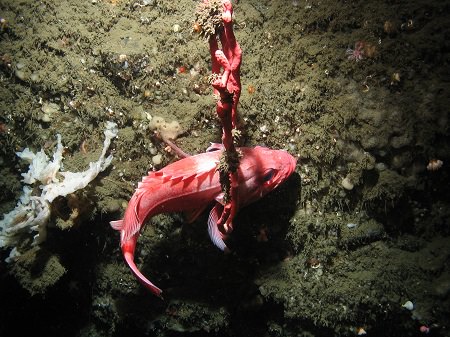
Conservation Science Projects
Over the past decade there have been several expeditions to map, explore and characterize the seafloor of the sanctuary with modern mapping instruments and visualization tools. Mapping data has been collected in 2009, 2011, 2016 and 2017, by several partner institutions, NOAA Ocean Exploration and Research and NOAA Ship Okeanos Explorer, Ocean Exploration Trust, US Geologic Survey, and Greater Farallones sanctuary. These various mapping efforts collected data on bottom depth, slope, and the hardness of the substrate.
This "flythrough" video shows highly detailed maps of topography and substrate type for Rittenburg Bank, Farallon Escarpment and Cochrane Bank (labeled as "West Fanny Shoal" in the video). The video was produced by NOAA's National Centers for Coastal Ocean Science, USGS, and GFNMS.
The map products were used to identify areas to explore and characterize the sea floor communities using remotely operated vehicles (ROV). ROV surveys were performed in 2012, 2014, and 2016, collecting over 100 hours of video and thousands of still images of deep rocky reef The Football, Rittenburg Bank, Cochrane Bank, Farallon Escarpment, Arena Canyon and Pioneer Canyon. These areas range in depth from 100 meters from the top of Rittenburg Bank to over 1800 meters in depth in Pioneer Canyon.
The sanctuary works with many institutions to plan and execute exploration and quantitative surveys of the sea floor. In addition to our partners that help with mapping efforts, the sanctuary also works with other national marine sanctuaries, NCCOS, National Marine Fisheries Service, NOAA's Deep Sea Corals Research and Technologies Program, and taxonomists from the California Academy of Sciences, the Harvard Museum of Comparative Zoology, and the Royal British Columbia Museum to characterize the sanctuary sea floor habitats.

